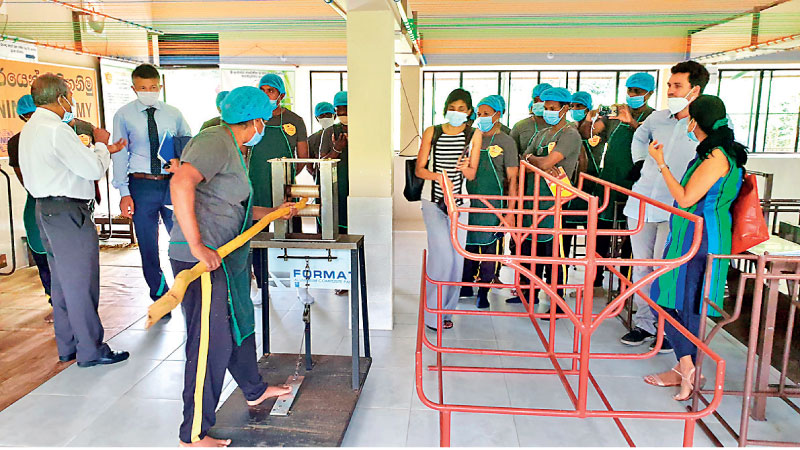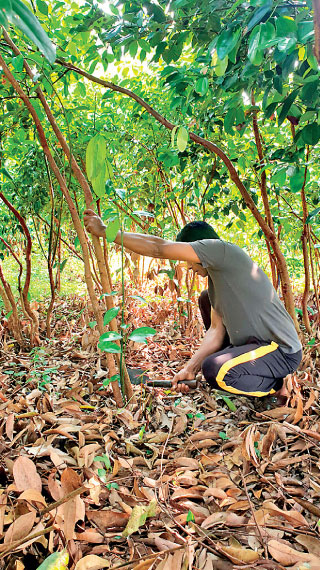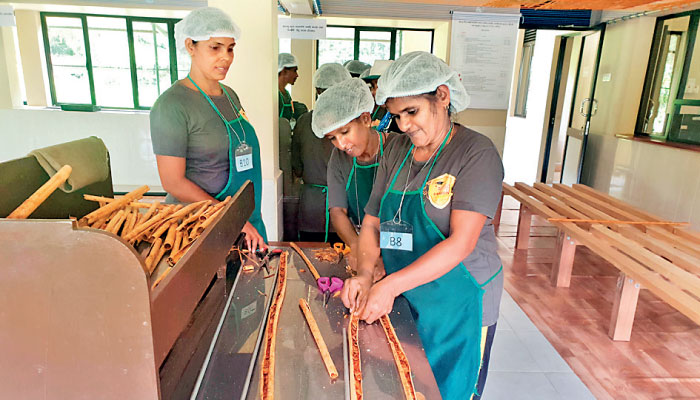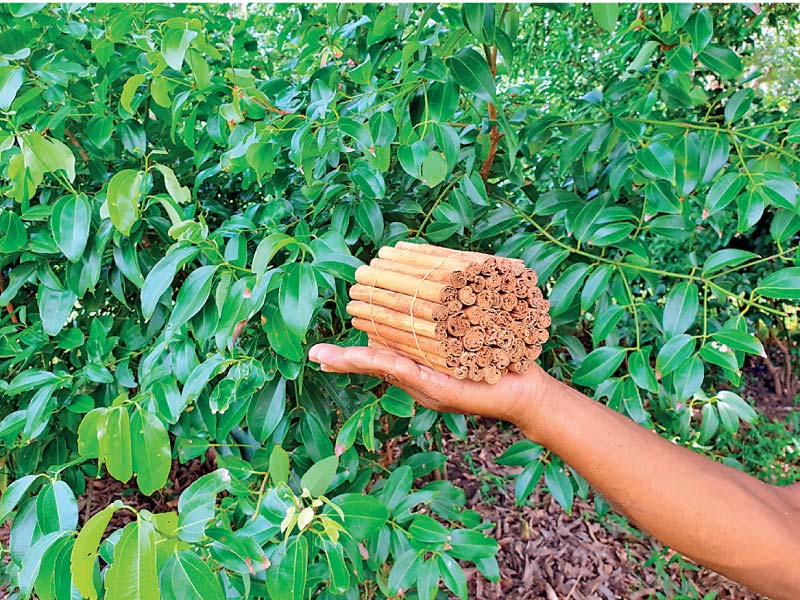Wednesday Dec 03, 2025
Wednesday Dec 03, 2025
Thursday, 24 March 2022 02:56 - - {{hitsCtrl.values.hits}}

Expert knowledge shared at CTA
|
By Randima Attygalle
 |
| CTA Chairman Sarada de Silva |
 |
Kosgoda is the cinnamon hub of Sri Lanka, with the neighbouring Balapitiya considered to be this coveted spice’s hometown. Strategically located within, is the Cinnamon Training Academy (CTA) which is now into its 10th year and is recognised as a successful public-private partnership by WTO-STDF.
CTA, which had to brave difficult times due the COVID pandemic in the past two years, has set its wheels back in motion. With Ceylon Cinnamon receiving Geographical Indication Certification (GI) from the EU in early February this year, Sri Lanka’s first ever GI, CTA is also given a thrust to add more muscle to its mandate.
The primary objective of CTA is to “provide services to train value chain actors in the cinnamon industry for increasing the production capacity and enhance quality and standards compliance capacity to elevate the industry to a national symbol of quality and excellence”. The CTA has pioneered an international trade compliance system for Sri Lanka’s cinnamon industry.
Where expertise and technology meet
The CTA is also credited for implementing a system which recognises the industry experts through prior learner’s assessment programme (RPL) in collaboration with NAITA. The CTA also implements consultancies and advisory services in disseminating the knowledge and technology for existing and new investments in the industry. “The involvement of a panel of industry experts is our core strength,” notes CTA Chairman Sarada de Silva who is also the head of the Ceylon Cinnamon Association, Ceylon Cinnamon Geographical Indication Association and the Founder Chairman of Spice Council of Sri Lanka.
The CTA, which is open to multiple stakeholders of the industry including estate owners, processors, growers, supervising staff, exporters and newcomers to the industry, is backed by such lead players in the industry in terms of expertise and investment. The investment in the CTA entails contribution by WTO-STDF ($ 400,000), UNIDO ($ 200,000), FAO ($ 30,000), national budget (Rs. 28.5 m) and industry stakeholders from the private sector (land valued at Rs. 34 m and Rs. 2 m to the capital).
“The STDF-facilitated partnership was implemented by UNIDO from 2012 to 2016. While the Sri Lankan Government financed the CTA’s buildings, stakeholders in the cinnamon industry donated land for it and invested additional funds. The STDF project also funded the development of competency standards and tailored a curriculum, based on the international standards and set up and piloted the training program in collaboration with other partners,” explained De Silva who is among the leading campaigners and investors of the project.
Offering NVQ qualification
This non-profit educational organisation also delivers hands-on training on food safety and hygiene in the cinnamon value chain, Good Agricultural Practices (GAP) Good Manufacturing Practices (GMP), Hazard Analysis and Critical Control Points (HACCP), ISO 22000 and occupational standard schemes for cinnamon processing. The CTA, as its Chairman points out is also the first to develop the first nationally (TVEC) accredited vocational training program to promote internationally recognised food safety certification focused on a particular value chain.
The nationally accredited training framework of the CTA recognises the skills and capacities of partners in the industry including harvesters, processors, factory officers, supervisors and field officers, awarding a National Vocational Qualification (NVQ) for level 3 and 4 for those qualifying after an assessment carried out by TVEC (Tertiary and Vocational Education Commission) accredited assessors.
The CTA, which is a public-private partnership model that is lauded internationally, has raised the bar for the much sought-after world’s best cinnamon by ushering a transformational change in the sector and thereby strengthening the presence of Ceylon Cinnamon in the international market, observes De Silva. “The cost of the courses at the Academy is shared between the participants and the donor agencies and NGOs. However, for processors (traditionally called peelers) who are unable to meet the cost, courses are offered at a substantial discount.”
Based on the initial success of the Academy, additional funding of $ 220,000 was provided by the EU to expand its activities in a bid to add value to cinnamon. This initiative also resulted in the ‘Bought Tree Processing Factory’ to support smallholders and CTA’s financial sustainability during the harvest season when demand for training is less. “The small holders can sell their trees to the factory or get their cinnamon processed here for a nominal fee,” De Silva explains.
|
Taking Lankan spices to the next level
The upgrading of six cinnamon processing centres is another recent feat by the CTA. These newly upgraded processing centres enable GMP certification as an essential prerequisite to comply with international food safety standards and buyer requirements. The decent working environment provided by the Academy has also attracted more females to the sector, notes its Chairman.
Several schemes are in the pipeline to expand the activities and services of the CTA and among them is to launch a ‘mobile service’ where cinnamon processors from ‘unconventional cinnamon’ regions such as Moneragala, Badulla, Jaffna and Mulativu are tapped. “Sheltering them at the CTA in Kosgoda could sometimes be costly and not practical for those who have to travel far, hence we have plans to reach out to them to hone their skills,” notes De Silva.
Replicating the CTA’s model to take the rest of the Sri Lankan spice industry to the next level is also envisaged. “In the next few years, we also hope to introduce NVQ standards for pepper, clove and nutmeg and expand CTA as a Spice Academy,” he adds.
Spice which launched many ships
Obtaining GI in the EU for Ceylon Cinnamon in February this year was a historical win for the spice which launched many ships in search of it. The pride of the place cinnamon occupied in history is well documented. Pliny, the Roman elder, records that in Rome cinnamon was twice the value of silver. According to Encyclopaedia Britannica, cinnamon was once more valuable than gold. Sri Lankan kings sent emissaries with ships full of Cinnamon, Pearls and Ivory to the courts of Rome and China and beyond. Dr. Colvin R. de Silva in his thesis wrote: ‘The vagaries of wind and weather brought Portuguese to Sri Lanka but the lure of cinnamon made them stay.’ Historical records also attest to the fact that our old ports exported cinnamon among the other commodities. Health benefits of cinnamon are well established today.
Today Ceylon Cinnamon is exported to over 65 countries and some are re-exported to other countries. Mexico still remains the largest buyer of Ceylon Cinnamon importing 50% of our production. Moving away from traditional bulks, cinnamon is largely exported in Quills, Cut Quills, powder and oil from today. According to the figures of the Department of Export Agriculture (DEA), in 2021 Sri Lanka has exported 18813.52 mt. of cinnamon valued at Rs. 46 billion ($ 230.68 million), 307.29 mt. of cinnamon leaf oil amounting to Rs. 1,384.50 million ($ 6.96 million) and 73.98 mt. of cinnamon bark oil amounting to Rs. 2629.14 million ($ 13.22 million).
Hard-won GI
A geographical indication of GI is a name or a sign used on products which corresponds to a specific geographical location or origin. Ceylon Cinnamon donning GI is the fruit of an arduous journey undertaken by a group of people committed to the cause. “We have been working on it since 1994 when we got Ceylon Cinnamon included in the National Intellectual Property (NIPO) Law along with Ceylon Tea and Ceylon Blue Sapphires (both Ceylon Tea and Ceylon Blue Sapphires are yet to receive GI). In 2012 we launched the Ceylon Cinnamon Lion Logo with the EDB and in 2013 it was launched internationally at Anuga Trade Fair,” recaps de Silva, a third-generation cinnamon industrialist who had tirelessly worked towards the cause.
Getting GI after a long battle is not the end of the tunnel, maintains the senior professional. “In our NIPO law there is still no separate or special section on protecting GI and no local register either. We need to expedite the legal process of accommodating Ceylon Cinnamon.”
Need for international promotion
De Silva is critical of the Government agencies wanting to take the full reins of the GI. “They need to be mindful of taking the entire value chain into the picture and not only the producer and the end consumer,” notes De Silva who urges the EDB to be more proactive in branding and promoting Ceylon Cinnamon in the wake of it having received GI. “Getting GI alone will not fetch our cinnamon a better price, we need to promote it and have a brand promotion internationally at a few notable forums in Geneva, Vienna, Brussels and London for instance. Most importantly, EDB should promote and defend the market for our cinnamon against unscrupulous players for which our legal framework needs more teeth,” added De Silva.

Training at CTA

